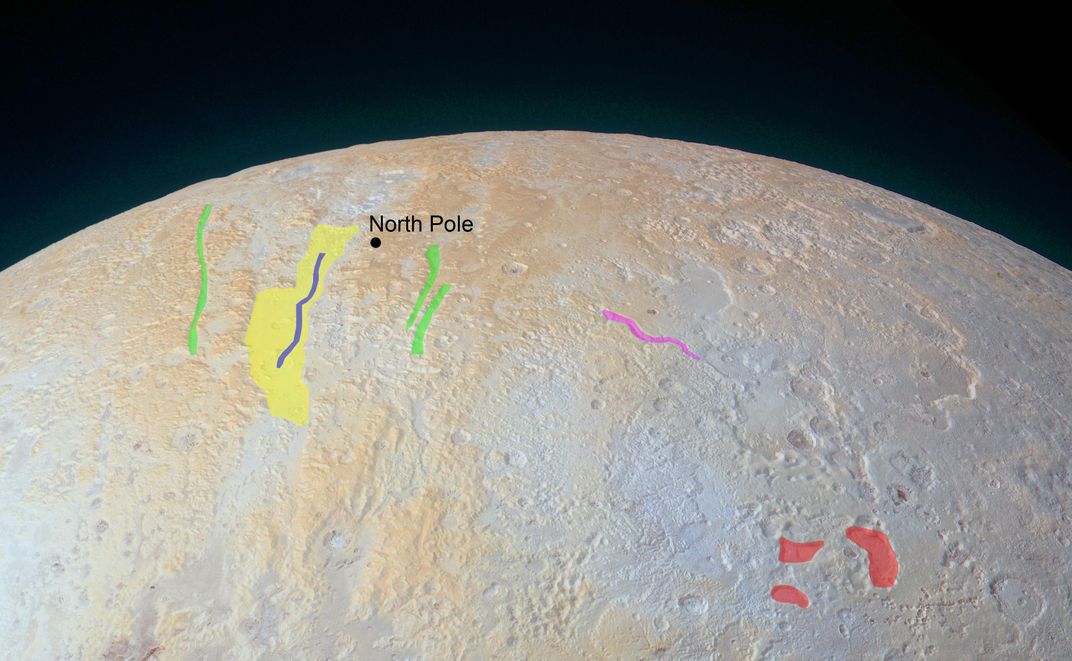Pluto’s North Pole Is Streaked With Canyons
Enormous pits and frozen valleys straddle Pluto’s northern hemisphere
/https://tf-cmsv2-smithsonianmag-media.s3.amazonaws.com/filer/37/b9/37b98456-69f7-480b-a81c-194d207bb96d/nh-northpolerotatedcontrast.jpg)
Until NASA’s New Horizons spacecraft flew by Pluto last year, all scientists knew of the dwarf planet's looks was based on tiny, pixilated smudges. But the data pouring in brought the charismatic orb into focus. Now, a new NASA photo reveals miles-wide pits, frozen canyons and deep valleys sprawling across the dwarf planet’s north pole.
Known as the Lowell Regio (named after Percival Lowell, whose work led to Pluto’s discovery), Pluto’s north pole is streaked with enormous canyons that can be seen running vertically across the left side of the photo. The largest, which is highlighted in yellow in the annotated image below, is about 45 miles wide at its largest point and is surrounded by smaller canyons about six miles wide.
What’s curious about these canyons is that they are much older than any of the others found on Pluto’s surface, Mariella Moon writes for Engadget. By looking at the canyon’s walls, NASA researchers noticed that the ones stretching across the north pole are crumbling at the edges as opposed to the younger canyons found in other regions that have more sharply defined walls. By examining these canyons closely, researchers might be able to glean new insights into how Pluto’s early seismic activity shaped the face of the dwarf planet.

Towards the lower right of the photo is another fascinating feature: giant pits that span up to 45 miles across and drop about 2.5 miles below the surface. Highlighted in red, these pits are irregularly-shaped, which makes it unlikely that they were caused by meteor impacts. Instead, these features might indicate places where subsurface ice melted and collapsed, causing enormous cave-ins on the surface, Loren Grush writes for The Verge.
While the dwarf planet's surface coloring in the photograph have been enhanced to make them more visible, they are unusual. At lower elevations, Pluto’s surface is generally a bluish-grey, but at high elevations near the north pole, the ground appears to take on a yellowish color that NASA researchers haven’t seen anywhere else on the distant dwarf planet.
“One possibility is that the yellow terrains may correspond to older methane deposits that have been more processed by solar radiation than the bluer terrain,” Will Grundy, a NASA researcher at the Lowell Observatory in Flagstaff, Arizona, says in a statement.
Infrared scans made by New Horizons indicate that the Lowell Regio is covered in methane ice, instead of the nitrogen ice that covers most of the rest of Pluto’s surface, and could be responsible for the region’s yellow color.
New Horizon’s photographs may be everywhere on the internet these days, but compared to what scientists had to work with before, they are a treasure trove of information about our most distant neighbor in the solar system. But if you are ready for a new planet to ogle, in just a few months, NASA’s Juno spacecraft will finally complete it's five year venture to Jupiter. It's bound to produce some intriguing images.